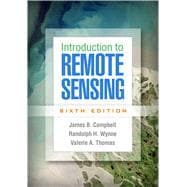
Introduction to Remote Sensing
by Campbell, James B.; Wynne, Randolph H.; Thomas, Valerie A.Buy New
Rent Textbook
Rent Digital
Downloadable: 180 Days
Downloadable: Lifetime Access
Used Textbook
We're Sorry
Sold Out
This item is being sold by an Individual Seller and will not ship from the Online Bookstore's warehouse. The Seller must confirm the order within two business days. If the Seller refuses to sell or fails to confirm within this time frame, then the order is cancelled.
Please be sure to read the Description offered by the Seller.
Summary
New to This Edition
*Discussions of Landsat 8 and Sentinel 2; the growth of unmanned aerial systems; mobile data collection; current directions in climate change detection, fire monitoring, and disaster response; and other timely topics.
*Additional cases, such as river erosion; the impact of Hurricane Sandy on Mantoloking, New Jersey; and Miami Beach as an exemplar of challenges in coastal communities.
*Revised throughout with 60% new material, including hundreds of new full-color figures.
*New chapters on remote sensing platforms, agriculture, and forestry.
Author Biography
Randolph H. Wynne, PhD, is Professor in the Department of Forest Resources and Environmental Conservation at Virginia Tech. He also serves as Director of the Interdisciplinary Graduate Education Program in Remote Sensing. He teaches courses focused on the environmental and natural resources applications of remote sensing at the senior and graduate levels. Dr. Wynne's research interests are in the applications of remote sensing to forestry, natural resource management, ecosystem ecology, and earth system science. He is a recipient of the Award in Forest Science from the Society of American Foresters. Dr. Wynne is Coeditor of the journal Science of Remote Sensing and Associate Editor of Remote Sensing of Environment.
Valerie Thomas, PhD, is Professor in the Department of Forest Resources and Environmental Conservation at Virginia Tech. She also serves as Co-Director of the Center for Environmental Analytics and Remote Sensing within the College of Natural Resources and Environment. Dr. Thomas teaches remote sensing courses in forest lidar applications and hyperspectral applications for natural resources. She also teaches about the linkages between forests, society, and climate. Dr. Thomas's research related to remote sensing of forest cover, function, and change has been funded through federal and state agencies and by industry.
Table of Contents
1. Introducing Remote Sensing Basics
2. Electromagnetic Radiation
3. Remote Sensing Platforms
II. Image Acquisition
4. Digital Mapping Cameras
5. Digital Imagery
6. Image Interpretation
7. Land Observation Satellites
8. Active Microwave
9. Lidar
10. Thermal Imagery
III. Analysis
11. Statistics and Preprocessing
12. Image Classification
13. Accuracy Assessment
14. Hyperspectral Remote Sensing
15. Change Detection
IV. Applications
16. Plant Science Fundamentals
17. Agricultural Remote Sensing
18. Forestry
19. Earth Sciences
20. Coastal Processes and Landforms
21. Land Use and Land Cover
Index
An electronic version of this book is available through VitalSource.
This book is viewable on PC, Mac, iPhone, iPad, iPod Touch, and most smartphones.
By purchasing, you will be able to view this book online, as well as download it, for the chosen number of days.
A downloadable version of this book is available through the eCampus Reader or compatible Adobe readers.
Applications are available on iOS, Android, PC, Mac, and Windows Mobile platforms.
Please view the compatibility matrix prior to purchase.
